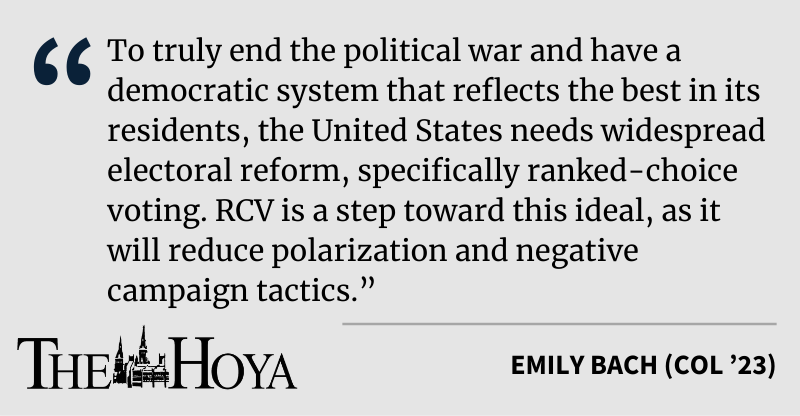Regardless of the outcome, the 2020 presidential election has taught us that polarization is here to stay, barring drastic changes to our electoral system. Although President-elect Joe Biden promises to be a president for all Americans, his reassurance election week that “[t]he purpose of our politics isn’t to wage total and unrelenting war” is not enough. To truly end the political war and have a democratic system that reflects the best in its residents, the United States needs widespread electoral reform, specifically ranked-choice voting. RCV is a step toward this ideal, as it will reduce polarization and negative campaign tactics.
As both parties move closer to their respective extremes, American politics lack thoughtful consideration of the opposing side. The population of liberal Republicans and conservative Democrats seems to be shrinking dramatically. Our current two-party system reduces our capacity for respectful civil discourse and mutual respect.
Given the inaccuracy of many preelection polls and the presidential election’s unexpected closeness, I certainly question whether we can truly heal from the wounds of division. Despite Biden’s decisive win, many people across the country will be displeased Jan. 20.
Americans need to restore faith in the democratic process. Furthermore, our country needs voters to be more satisfied with the pool of candidates. Leading up to the 2016, 2018 and 2020 elections, I constantly heard pleas of “everything is at stake,” but not everything should be. Voting should be a civic duty that excites us, not one that fills us with dread and fear. To fulfill these goals, the United States must implement RCV in as many places as possible.
RCV makes voting an instant runoff. Voters rank all or several of their choices, making a majority required for victory. If no candidate has a majority of votes, the candidate with the lowest number of votes is removed from consideration and the second-choice votes are added to the count. If necessary, this process continues until one candidate reaches a majority of votes.
In short, RCV leads to greater faith in the system, as evident from higher turnout rates in places like Minneapolis, which uses RCV. It should be implemented in all U.S. elections. By abolishing the current plurality rule, voters’ preferences are more accurately reflected in election results. RCV also eliminates the need for strategic voting. Instead of feeling obligated to choose the “lesser of two evils,” voters are free to choose a first-choice candidate that matches their preferences without the concern that their votes will not matter.
With RCV as a motivating factor, we can maintain the high voter turnout rates of 2020. Even better, turnout would be high because voters are excited about their voices being heard and accurately reflected, not because they fear the worst from one of the candidates. Candidates who align less with either of the two political extremes but appeal to voters’ views could still hold a place on the ballot.
RCV is not some unrealistic hypothetical. A growing number of universities elect student leaders through RCV, and the Georgetown University Student Association elections are decided by RCV every year. State and local governments throughout the country also use RCV; for example, Maine recently adopted the new system and held its first RCV election in 2018.
Politicians in these places are far less divisive than the attack-based presidential campaigns that have defined 2020. RCV incentivizes candidates to please voters across the political spectrum to gain second- and third-choice votes, not to attack opposition and rally extremist voters.
In turn, campaigns become more civil and embody what we should hope to see in a future healed country. For instance, a 2020 University of Technology Sydney study found that in U.S. cities, “the introduction of [RCV] improved the civility of debates[,] with candidates substituting negative or neutral words for positive words.”
Finally, with RCV and an instant runoff system, elections will be less expensive. For instance, neither Georgia Senate race had a clear winner. By state law, these outcomes necessitate runoffs for both Senate seats in January. With a delayed runoff system such as this one, campaigns and outside groups spend millions of dollars to reach a majority when one RCV ballot could do the same.
RCV will extend the only definitive victory for democracy we saw this past election by keeping voter turnout high. By reducing polarization, it will eliminate the challenges 2020 brought to our voting system and our sense of national identity. It is the solution our country desperately needs.
Politicians may be reluctant to implement RCV because it gives the Democratic and Republican parties less power. Many states and localities have adopted it by referendums, however, including New York City, Maine, and, in this past election, Alaska. If you live in a state or region that has a referendum process, you can work to get RCV on the ballot and sign any available petition.
Emily Bach is a sophomore in the College.









